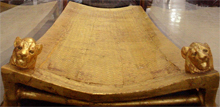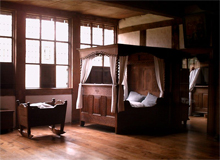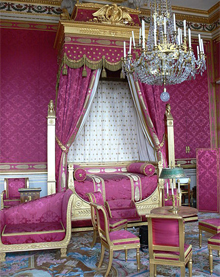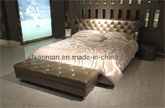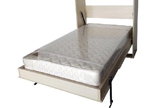| A bed is a piece of furniture used as a place to sleep or relax. It has a secondary use as a location to engage in sexual relations. Most modern beds consists of a mattress on a bed frame, with the mattress resting either on a solid base, often wooden slats, or a sprung base. In North America many beds include a box spring inner-sprung base, a large mattress-sized box containing wood and springs that provide additional support and suspension for the mattress. View more… |
History of the bed
| Ancient world Early beds were little more than piles | Medieval Europe The ancient Germans lay on the floor on beds of leaves covered with skins, or in a kind of shallow chest filled with leaves and moss. In the early Middle Ages they laid carpets on the floor or on a bench against the wall, placed… view more… | |
| of straw or some other natural material (e.g. a heap of palm leaves, animal skins or dried bracken). An important change was raising them off the ground, to avoid drafts, dirt, and pests. Bedding dated to 77,000 BP was discovered in Sibudu Cave, South Africa. The bedding consists of sedge and other monocotyledons topped with the leaves of Cryptocarya woodii Engl. Beds found in a preserved village in northern Scotland which were raised boxes made of… view more… | | Renaissance and modern Europe In the 17th century, which has been called "the century of magnificent beds", the style a la duchesse, with tester and curtains only at the head, replaced the more enclosed beds in France, though they lasted much longer in England. Louis XIV had an enormous number of sumptuous beds, as many as 413 being described in the inventories of his palaces. Some of them had embroideries enriched with pearls, and… view more… |
| Bed sizes Bed sizes vary considerably around the world, with most countries having their own standards and terminology. While the "double" size appears to be standard among English speaking countries, based on the imperial measurement of 4 ft 6 in by 6 ft 3 in (137 cm x 190 cm), the sizes for other bed types tend to vary. The mainland European sizes differ, not merely because of the use of the metric system. In the mid 1950s the U.S. bedding industry introduced a new size, the King Size. A king-sized bed differs from the other sizes in implementation, as it is not common to have a king-sized box spring; rather, two smaller box-springs are used under a king-sized mattress. It is a common misconception that in a U.S. "standard" or "eastern king", the box springs are identical in size to a "twin extra-long"; however, "twin extra-long" mattresses next to each other add up to 78 inches wide instead of the 76 inch width that is standard for an "eastern king". Another size variant in the United States is the "California King", which measures 72 inches wide by 84 inches long (narrower and longer than the Eastern King). |
Types of beds
| There are many varieties of beds: | |||||
| | | | | | |
| Bed frames Bed frames, also called bed steads, are made of wood or metal. The frame is made up of head, foot, and side rails. For heavy duty or larger frames (such as for queen- and king-sized beds), the bed frame also includes a center support rail. These rails are assembled to create a box for the mattress or mattress/box spring to sit on. Though not truly parts of a bed frame, headboards, footboards, and bed rails can be included in the definition. Headboards and footboards can be wood or metal. They can be stained, painted, or covered in fabric or leather. |
| Buy guides: | |||

